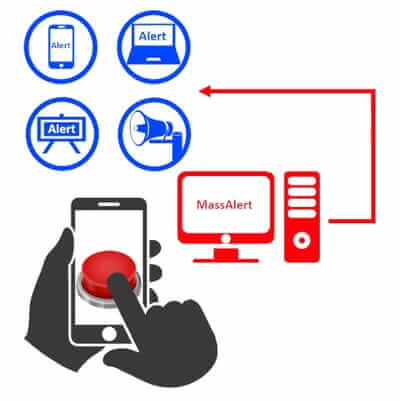ATI Systems, a global leader in mass notification systems, announced today the release of a new version of its market leading MassAlert®platform.
MassAlert® is a scalable mass notification platform that integrates with 3rd party services such as electronic notification systems as well as the federal integrated public alerts and warning systems (IPAWS.) It provides an easy to use and customizable notification solution with enhanced interoperability.
The MassAlert® server has a desktop client as well as web & mobile that run over both private LAN and the internet allowing emergency operators to access the system from anywhere.
This article will highlight 3 important features and upgrades of the MassAlert® platform:
Tentative siren locations are selected on the basis of power line locations to eliminate the cost of extending power lines over great distances. Several computer iterations are made to determine the optimum number and locations of sirens.
MassAlert® enables multiple map views linking, providing an important advantage to the operator by viewing spatially related content side by side. Maps can be synchronized together so that they can be used simultaneously to illustrate any required scenario.A primary site map drives and coordinates all the other views linked to it.
For example, the primary site map might show the location of all outdoors sirens and buildings with indoor systems.When a designated building is clicked, the view will navigate to that building’s floor plan displaying the location of the indoor alert units.
To improve the visual viewing, the maps layout can be arranged so that each can be seen on separate physical displays (dual displays being popular) or they can all be seen on the same display.
The following scenarios are only a small subset of the wide array of possible integrations that can be accomplished through the MassAlert®platform.
Integrated Public Alert and Warning System (IPAWS)
MassAlert®is CAP compliant which enables it to integrate with numerous systems to automatically activate ATI’s sirens and other on-site devices based on IPAWS alerts.
It has a flexible rules engine that allows operators to configure which IPAWS alerts the system shall respond to and what type of action to take. When paired with MassAlert®text-to-speech (TTS) capability, IPAWS alerts can be converted directly to speech and broadcasted over ATI’s sirens.
IPAWS integration process involves the following 4 steps (illustrated in figure 1):
Step-1: Alert Origination
Local, state, territorial, tribal or federal alerting authorities create a CAP message and send it to the IPAWS Open Platform for Emergency Networks (OPEN.) Federal includes NOAA’s National Weather Service.
Step-2: Alert Aggregation
The centralized alert aggregator receives CAP alert messages from various message origination tools and authenticates the sender. Alerts will be available on the internet through ATOMS feeds.
Step-3: Alert Dissemination
MassAlert® will monitor the IPAWS ATOM feed, using its rule engine, to disseminate alerts to the proper channels in the proper format. For example, if the national weather service sends out a tornado threat, MassAlert® will display polygons on the map representing the affected areas showing ATI’s siren location and sound coverage.
Step-4: Alert Delivery
MassAlert® delivers the messages through multiple channels including ATI’s Outdoor sirens, ATI’s Indoor speakers, Networked computers, Digital Signages, Existing paging systems, etc.

Authorized users can use the panic button mobile application on a smartphone or smartwatch to initiate a preset alert and have it distributed over multiple channels.
For example, schools may enable students and staff in danger to instantly alert campus security personnel. Alert messages are delivered to the security department and provide the student’s/staff’s name and GPS location, enabling security personnel to respond faster and more effectively.
The panic button mobile application turns the students’ and staff’s smartphones into “panic buttons” – without the maintenance, costs and limitations of fixed systems.

MassAlert® integrates with PTT, one of ATI’s mobile applications, allowing authorized operators to remotely do live public announcements from their smartphones.

MassAlert® employs layered security features such as:
The MassAlert® upgrade demonstrates ATI’s commitment to constantly improve their state-of-the-art technology to provide the most advanced, reliable and secure mass notification system.
Learn about us at https://americansecuritytoday.com/ati-enhances-massalert-to-improve-user-response-to-crisis-situations/